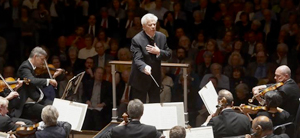by Daniel Hathaway

As usual, Dohnányi moved the furniture for his weekend performances, reseating the strings with second violins on stage left with cellos next to the firsts (basses behind) and violas next to the seconds, a move which subtly changed balances among the string sections, sometimes at the expense of presence from the seconds, whose tone holes were facing inward rather than toward the audience.
Schumann’s fourth symphony, which occupied the short first half of the program, took ten years to come into focus from its original form in 1841 to its revision in 1851. Schumann designed its four movements to be played end-to-end without pauses, which gives an unusual unity to the work — beyond its cyclic elements and its coded themes — and concentrated the audience’s attention at Severance in a rather magical way. Even on this wintry night nary a cough was heard during the music.
Conducting from memory, Dohnányi concentrated on the big narrative of the work, making supple transitions between sections and molding its nuances like someone who knows his way around a familiar and cherished landscape. The Presto ending of the last movement was as thrilling as the ending of the Scherzo was poetic. Especially notable in the orchestral blend were the brass, who interleaved their burnished sound inside that of the strings and winds.
The second symphony, premiered in 1846 by the Leipzig Gewandhaus Orchestra under Felix Mendelssohn, marked an arrival point for the composer in his handling of larger forms but is less immediately engaging than the fourth, which seems fresher and more inventive. And after the straight-through performance on the first half of the concert, the conventional pauses between movements seemed strangely interruptive.
Again, Dohnányi’s interpretation was broad and wide in its brush strokes, but here some ensemble detail was glossed over as a result. The Scherzo was thrillingly fast with alluring interludes of repose, and Dohnányi purposefully drove the finale home — after several of Schumann’s false endings — amid a big, festive tune and an explosion of timpani strokes.
The music director laureate got called back to the stage several times after each symphony and was as roundly acknowledged by the musicians as by the audience. A short evening at Severance Hall — 95 minutes end to end — but a memorable one.
Published on ClevelandClassical.com April 3, 2014
Click here for a printable version of this article.



